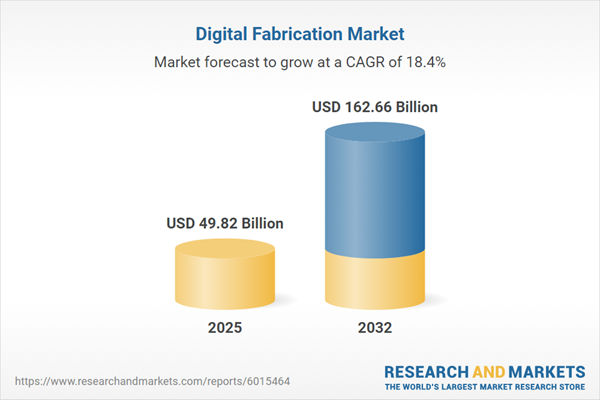Speak directly to the analyst to clarify any post sales queries you may have.
Digital fabrication is rapidly transforming global manufacturing with technology-driven innovation, offering businesses scalable solutions and new efficiencies. Senior decision-makers now face a landscape where agility, customization, and integrated production capabilities are central to competitive advantage.
Market Snapshot: Digital Fabrication Market Growth and Trends
The global digital fabrication market expanded from USD 42.20 billion in 2024 to USD 49.82 billion in 2025, demonstrating sustained momentum. Expected to progress at a CAGR of 18.37%, the sector is projected to reach USD 162.66 billion by 2032. Demand spans industries from automotive and aerospace to healthcare and consumer electronics. This growth is driven by continuous innovation, broadening adoption, and a shift toward end-to-end production solutions across the manufacturing value chain.
Comprehensive Scope & Segmentation of the Digital Fabrication Market
- Technology Types: 3D Printing technologies such as Binder Jetting, Digital Light Processing, Fused Deposition Modeling, Selective Laser Sintering, Stereolithography; CNC Machining methods including Drilling, Milling, Turning; Electron Beam Melting; Laser Cutting with CO2 and Fiber Lasers.
- Material Types: Ceramics, Composites, Metals, Polymers.
- End User Sectors: Aerospace and Defense, Automotive, Consumer Electronics, Education, Healthcare, Industrial.
- Offerings: Hardware (machine sales, peripherals, ancillary equipment), Services (design consultancy, maintenance), Software (workflow, simulation, machine control).
- Regions: Americas (North America, Latin America), Europe, Middle East, Africa, Asia-Pacific. Key countries in each region include the United States, Canada, Brazil, United Kingdom, Germany, France, China, India, Japan, and Australia, among others.
Key Takeaways for Senior Decision-Makers
- Digital fabrication has evolved from traditional prototyping to core industrial functions, enabling rapid product development and tailored manufacturing at scale.
- The ecosystem now integrates hardware, software, and services, allowing businesses to optimize supply chains and introduce higher levels of customization and efficiency.
- Adoption of advanced production materials and integration of AI and automation are reshaping quality control, design iteration, and process uptime.
- Regional strategies, including investment in micro-factories and local supply chains, are emerging to address logistical, environmental, and geopolitical challenges.
- Sustainability in manufacturing is emphasized through increased use of recycled and circular materials, aligning with broader industry commitments.
- Collaborative initiatives among equipment manufacturers, software providers, and material science firms are driving innovation and accelerating time-to-market for complex products.
Analyzing Tariff Impact on Competitive Dynamics
With the implementation of new United States tariffs in 2025, digital fabrication stakeholders have experienced shifts in supply chain management and sourcing strategies. Increased costs on imported raw materials like metal powders and advanced polymers prompted firms to prioritize domestic alternatives and restructure supplier agreements. Equipment manufacturers and service providers are mitigating tariff-related impacts through localized assembly and bundled service offerings, enhancing operational resilience and supporting continued innovation despite geopolitical shifts.
Methodology & Data Sources
This report combines primary research—comprising direct interviews with industry veterans, technology providers, and end users across multiple sectors—with comprehensive secondary research. Peer-reviewed publications, corporate documents, and regulatory sources form the backbone of the data, enhanced through rigorous triangulation and cross-verification. The analysis ensures robust, actionable insights specific to evolving industry demands.
Why This Report Matters
- Supports informed investment planning by outlining technology adoption curves, segmentation relevance, and cross-regional growth drivers.
- Delivers benchmark strategies, enabling leaders to capitalize on opportunities within customized manufacturing, value-chain integration, and supply chain optimization.
- Facilitates scenario planning for tariff impacts, sustainability imperatives, and strategic partnerships, helping organizations anticipate disruption and foster innovation.
Conclusion
This report provides clarity on the digital fabrication marketplace’s dynamic shifts, empowered by technological and regulatory developments. Senior executives can leverage these insights to chart effective routes to growth, resiliency, and sustainable advantage in advanced manufacturing.
Additional Product Information:
- Purchase of this report includes 1 year online access with quarterly updates.
- This report can be updated on request. Please contact our Customer Experience team using the Ask a Question widget on our website.
Table of Contents
3. Executive Summary
4. Market Overview
7. Cumulative Impact of Artificial Intelligence 2025
Companies Mentioned
The companies profiled in this Digital Fabrication market report include:- Stratasys Ltd.
- 3D Systems, Inc.
- HP Inc.
- General Electric Company
- EOS GmbH Electro Optical Systems
- SLM Solutions Group AG
- Desktop Metal, Inc.
- Carbon, Inc.
- Renishaw plc
- Materialise NV
Table Information
| Report Attribute | Details |
|---|---|
| No. of Pages | 187 |
| Published | October 2025 |
| Forecast Period | 2025 - 2032 |
| Estimated Market Value ( USD | $ 49.82 Billion |
| Forecasted Market Value ( USD | $ 162.66 Billion |
| Compound Annual Growth Rate | 18.3% |
| Regions Covered | Global |
| No. of Companies Mentioned | 11 |









